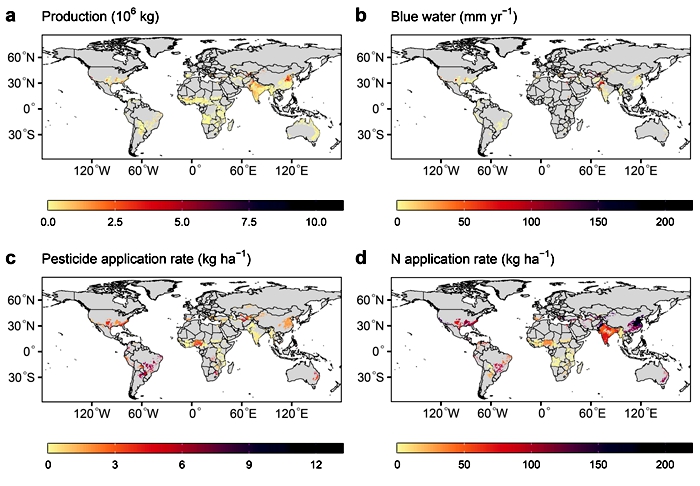Proposing strategies and approaches to enhance the sustainable development of the global cotton industry
Recently, the research entitled “Environmental impacts of cotton and opportunities for improvement” has been published by Nature Reviews Earth & Environment. In this paper, researchers from the Institute of Cotton Research (CCRI) systematically analyze the impact of global cotton industry chain on the environment, compared and analyzed the differences in environmental impacts between plant-based fibers, animal-based fibers, and synthetic fibers. This study proposed strategies and approaches to enhance the sustainable development of the cotton industry in terms of cultivation, processing, and using, providing theoretical support for the high-quality development of the cotton industry.
Cotton is one of the world's most important cash crops, with an average annual production of 25 million tons of cotton fiber over the past five years. However, the cotton industry inevitably has environmental impacts throughout its value chain, and there is an urgent need to conduct a global life-cycle assessment of cotton and develop strategies for sustainable production and utilization. The research team found that the global cotton fields average pesticide application with 1.57 kg ha-1 and average nitrogen and phosphorus fertilizer input with 150 kg ha-1. There are significant variations in irrigation, pesticide, and nitrogen fertilizer use among different cotton regions, with higher levels in economically developed regions and lower levels in regions with limited economic resources and water resources. The study also revealed that cotton textile manufacturing and usage has various environmental impacts. Depending on the impact category and country, cotton cultivation, textile manufacturing, or usage stages may dominate the overall life-cycle impacts. In terms of water usage, 97-98% is related to cotton cultivation, while only 2% is related to laundry activities. In terms of ecological toxicity, the toxicity of cotton textiles is mainly attributed to energy combustion processes. In terms of eutrophication, fertilizer input in cotton cultivation contributes 83% of the impact. In terms of carbon emissions, the carbon footprint of each cotton textile throughout its life-cycle ranges from 3 to 62 kg of CO2. Additionally, among all the environmental impacts investigated in the study, natural plant fibers have lower environmental impacts compared to animal and synthetic fibers. Finally, the study proposed strategies for the sustainable production and utilization of the cotton industry, such as optimizing irrigation systems, precise irrigation, targeted nutrient management, integrated pest control in cultivation, adopting green energy, innovative recycling methods, reducing wastewater discharge, and green purification in processing, as well as advocating hand washing, clothing recycling, and extending the lifespan of garments in usage. The research results provided important insights for the sustainable production and utilization of cotton and have significant guiding significance for addressing the environmental challenges faced by the cotton industry and ensuring its high-quality development.
This study was funded by the Intergovernmental Cooperation on National Key Research and Development Programs. Researchers Zhanbiao Wang from CCRI and Jing Huang from Southwest University of Science and Technology are the co-corresponding authors, post doctor from CCRI Zhenggui Zhang is the first author.
The article can be found: https://doi.org/10.1038/s43017-023-00476-z

Fig. 1 Global maps of cotton production, blue water use, pesticide use and nitrogen fertilizer use.
By Zhanbiao Wang (wang_zhanbiao@126.cn)
-
 Apr 18, 2024Opening Ceremony of the Training Workshop on Wheat Head Scab Resistance Breeding and Pest Control in Africa Held in CAAS
Apr 18, 2024Opening Ceremony of the Training Workshop on Wheat Head Scab Resistance Breeding and Pest Control in Africa Held in CAAS -
 Apr 03, 2024IPPCAAS Co-organized the Training Workshop on Management and Application of Biopesticides in Nepal
Apr 03, 2024IPPCAAS Co-organized the Training Workshop on Management and Application of Biopesticides in Nepal -
 Mar 28, 2024Delegation from the School of Agriculture and Food Science of University College Dublin, Ireland Visit to IAS, CAAS
Mar 28, 2024Delegation from the School of Agriculture and Food Science of University College Dublin, Ireland Visit to IAS, CAAS -
 Mar 25, 2024Director of World Food Prize Foundation visited GSCAAS
Mar 25, 2024Director of World Food Prize Foundation visited GSCAAS -
 Mar 20, 2024Institute of Crop Sciences (ICS) and Syngenta Group Global Seeds Advance Collaborative Research in the Seed Industry
Mar 20, 2024Institute of Crop Sciences (ICS) and Syngenta Group Global Seeds Advance Collaborative Research in the Seed Industry
